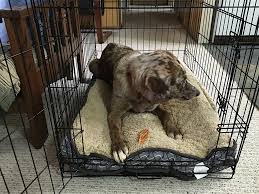Ask Crystal: Crate Training Troubleshooting
Welcome to “Ask Crystal,” where you can ask your pet behavior questions! You can submit your question for Crystal at the bottom of the page!

Dear Crystal,
We’ve always had crate trained dogs with no problems. But now we have a 6 months old dog, aren’t sure of house training, not sure if trustworthy in the bedroom without crate, and need to crate at night instantly with the door shut.
How do you deal with the refusal to go in and stay quiet? Our new dog has to be picked up and placed into the crate and then screams bloody murder, has attitude, flails around and makes all sorts of “I’m angry at you for doing this to me” noises, and after a couple of hours, I do mean like 2-2 1/2 hours, finally gets quiet. But that means the humans have to get up in a couple of hours or more. He’s not treat or food motivated, not affection motivated and appears to just ignore any good boy remarks or positive words and tone of voice. What is a person to do??
Sincerely,
Frustrated Dog Parent
Dear Frustrated,
This is a really great question. It’s all well and good to tell people they need to crate train. But it is called training for a reason. The dog needs to be trained to enjoy being in the crate. The time that takes can vary on the dog but it usually isn’t instant. What do we do in the meantime?
I suggest that you have a plan for how you will confine the new dog or puppy the first couple of weeks until he is trained. I would assume that any new dog has not been crate trained. Some dogs are so scared the first few days that they will go in and people think they are crate trained. A few weeks later when they are comfortable, they suddenly don’t like their crate. This likely means they were never really crate trained. It is well worth it to just take the time to train first.
 People often say that you should let the puppy cry it out. When the puppy is demand barking or whining a little to get out, yes that should be ignored. The caveat being that you know he doesn’t need to go to the bathroom. Before crating take the puppy outside to potty and then once you know he is empty ignore the whining. If you do need to let him out to see if he needs to potty, try to wait for a momentary pause in the barking to let him out. That might be a second or two of not barking.
People often say that you should let the puppy cry it out. When the puppy is demand barking or whining a little to get out, yes that should be ignored. The caveat being that you know he doesn’t need to go to the bathroom. Before crating take the puppy outside to potty and then once you know he is empty ignore the whining. If you do need to let him out to see if he needs to potty, try to wait for a momentary pause in the barking to let him out. That might be a second or two of not barking.
The exception to the rule is when the dog is panicking. This is very different from demand barking to get out. Some dogs cannot tolerate the confinement of a crate. They may be barking, howling and screaming nonstop for hours. The dog that is panicking may be throwing themselves around in the crate, frantically pawing, drooling, panting, urinating or defecating and sometimes they are actually injuring themselves to get out. A dog that is panicking is not learning a positive association with the crate and is likely creating a negative one.
Based on what you are telling me, this puppy does sound distressed at being crated at the moment. I would suggest thinking of an alternative confinement while you work on training.
One option might be to put a puppy pen either around the crate or at the crate opening and clip it to the crate. Make the crate comfy with bedding to entice the pup to want to sleep in it and leave the crate door off or tied open. Put some puppy pads down on the pen floor. He might go potty on the pads but at this point, that is ok. The primary focus should be teaching him to love being in his crate. Housetraining can come later once you can confine him in the crate without him panicking.
 Another option, could be a small room such as a bathroom or a utility room with a baby gate in the doorway. I always suggest a baby gate rather than closing the door because some dogs really don’t like the feeling of being closed in with the door shut but the baby gate helps them to feel more comfortable. If you had a heated/cooled basement or garage, you could put one of those outdoor fence enclosures up so that it is sturdier and larger than a crate.
Another option, could be a small room such as a bathroom or a utility room with a baby gate in the doorway. I always suggest a baby gate rather than closing the door because some dogs really don’t like the feeling of being closed in with the door shut but the baby gate helps them to feel more comfortable. If you had a heated/cooled basement or garage, you could put one of those outdoor fence enclosures up so that it is sturdier and larger than a crate.
One training trick that works for some dogs that are too scared to go in the crate is to get a crate where the top comes off and work on getting the dog to go into just the bottom part of the crate. This is usually less scary so you will be more likely to get the dog to go in. Once he is completely comfortable getting in the bottom part alone, we can add the top with the door off and start over with training. Next steps would be to put the door on and then after they are happily going in and staying in while you toss in treats, close the door briefly and then open it again.
If you spend a few weeks and just cannot get the dog to feel comfortable in the crate, you can consult a Certified Professional Dog Trainer to help you troubleshoot what you might be doing wrong. Another option is to consider some alternative confinement options.
If you need to leave the house for work during the day, you might consider dog daycare. Dog daycare is a great way to tire your puppy out and get him some dog socialization. There are a lot of great dog day care providers in the area.
You may find that he does ok in a small confinement space if he gets multiple bathroom breaks throughout the day and is provided lots of safe chewing items. This may be the most workable alternative for most people. You may be able to stagger lunch breaks with the other adult in the house to give him two breaks. Or maybe you hire a dog walker midday and tire him out and potty him so he just sleeps most of the day.
In regards to not being food motivated, I have a couple of thoughts. If you just brought the dog home, he may not have an appetite because he is stressed. When a dog doesn’t feel safe, the most important thing is to first feel safe and then they will be able to eat. This goes back to finding an alternative means of confinement and then giving him some time to settle in. The other thing is to be sure that you are using high value treats such as chicken, cheese or hot dogs. My educated guess is that he feels too stressed to eat at this point in time.
In all likelihood, with a couple weeks of solid training, he will be feeling much better about staying in his crate at night. It is really worth taking the time to train him and, in the meantime, not distressing him by forcing him into a situation he doesn’t know how to handle yet.
Until next time,
Crystal







